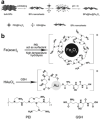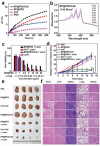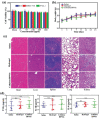Current Advances in Black Phosphorus-Based Drug Delivery Systems for Cancer Therapy
- PMID: 33717847
- PMCID: PMC7927632
- DOI: 10.1002/advs.202003033
Current Advances in Black Phosphorus-Based Drug Delivery Systems for Cancer Therapy
Abstract
Cancer has been one of the major threats to the lives of human beings for centuries. Traditional therapy is more or less faced with certain defects, such as poor targeting, easy degradation, high side effects, etc. Therefore, in order to improve the treatment efficiency of drugs, an intelligent drug delivery system (DDS) is considered as a promising solution strategy. Due to their special structure and large specific surface area, 2D materials are considered to be a good platform for drug delivery. Black phosphorus (BP), as a new star of the 2D family, is recommended to have the potential to construct DDS by virtue of its outstanding photothermal therapy (PTT), photodynamic therapy (PDT), and biodegradable properties. This tutorial review is intended to provide an introduction of the current advances in BP-based DDSs for cancer therapy, which covers topics from its construction, classified by the types of platforms, to the stimuli-responsive controlled drug release. Moreover, their cancer therapy applications including mono-, bi-, and multi-modal synergistic cancer therapy as well as the research of biocompatibility are also discussed. Finally, the current status and future prospects of BP-based DDSs for cancer therapy are summarized.
Keywords: biocompatibility; black phosphorus; cancer therapy; drug delivery; stimuli‐responsive release.
© 2021 The Authors. Advanced Science published by Wiley‐VCH GmbH.
Conflict of interest statement
The authors declare no conflict of interest.
Figures




















Similar articles
-
Functional black phosphorus nanosheets for cancer therapy.J Control Release. 2020 Feb;318:50-66. doi: 10.1016/j.jconrel.2019.12.013. Epub 2019 Dec 11. J Control Release. 2020. PMID: 31837354 Review.
-
Recent Advances in Metal-Organic Frameworks as Anticancer Drug Delivery Systems: A Review.Anticancer Agents Med Chem. 2021;21(18):2487-2504. doi: 10.2174/1871520621666210119093844. Anticancer Agents Med Chem. 2021. PMID: 33463479 Review.
-
Black phosphorus nanosheets-based platform for targeted chemo-photothermal synergistic cancer therapy.Colloids Surf B Biointerfaces. 2021 Feb;198:111467. doi: 10.1016/j.colsurfb.2020.111467. Epub 2020 Nov 12. Colloids Surf B Biointerfaces. 2021. PMID: 33302151
-
Black Phosphorus Nanosheet-Based Drug Delivery System for Synergistic Photodynamic/Photothermal/Chemotherapy of Cancer.Adv Mater. 2017 Feb;29(5). doi: 10.1002/adma.201603864. Epub 2016 Nov 24. Adv Mater. 2017. PMID: 27882622
-
Surface Engineering of Two-Dimensional Black Phosphorus for Advanced Nanophotonics.Acc Chem Res. 2024 Sep 3;57(17):2464-2475. doi: 10.1021/acs.accounts.4c00251. Epub 2024 Jul 11. Acc Chem Res. 2024. PMID: 38991156
Cited by
-
Facile Synthesis of Black Phosphorus Nanosheet@NaReF4 Nanocomposites for Potential Bioimaging.Nanomaterials (Basel). 2022 Sep 27;12(19):3383. doi: 10.3390/nano12193383. Nanomaterials (Basel). 2022. PMID: 36234512 Free PMC article.
-
Nanomaterials and their composite scaffolds for photothermal therapy and tissue engineering applications.Sci Technol Adv Mater. 2021 Jun 4;22(1):404-428. doi: 10.1080/14686996.2021.1924044. Sci Technol Adv Mater. 2021. PMID: 34121928 Free PMC article.
-
Photothermal therapy of copper incorporated nanomaterials for biomedicine.Biomater Res. 2023 Nov 24;27(1):121. doi: 10.1186/s40824-023-00461-z. Biomater Res. 2023. PMID: 38001505 Free PMC article. Review.
-
Massage-Mimicking Nanosheets Mechanically Reorganize Inter-organelle Contacts to Restore Mitochondrial Functions in Parkinson's Disease.Adv Sci (Weinh). 2025 May;12(20):e2413376. doi: 10.1002/advs.202413376. Epub 2025 Apr 13. Adv Sci (Weinh). 2025. PMID: 40223359 Free PMC article.
-
Bibliometric and visual analysis in the field of two-dimensions nano black phosphorus in cancer from 2015 to 2023.Discov Oncol. 2024 Jul 3;15(1):260. doi: 10.1007/s12672-024-01104-y. Discov Oncol. 2024. PMID: 38961044 Free PMC article.
References
-
- Keca J., Chen J., Overchuk M., Muhanna N., Maclaughlin C., Jin C., Foltz W., Irish J., Zheng G., Angew. Chem., Int. Ed. 2016, 55, 6187. - PubMed
-
- Huynh E., Leung B., Helfield B., Shakiba M., Gandier J., Jin C., Master E., Wilson B., Goertz D., Zheng G., Nat. Nanotechnol. 2015, 10, 325. - PubMed
-
- Lee N., Choi S., Hyeon T., Adv. Mater. 2013, 25, 2641. - PubMed
-
- Liu Y., Ai K., Liu J., Yuan Q., He Y., Lu L., Angew. Chem., Int. Ed. 2012, 51, 1437. - PubMed
Publication types
LinkOut - more resources
Full Text Sources
Other Literature Sources
